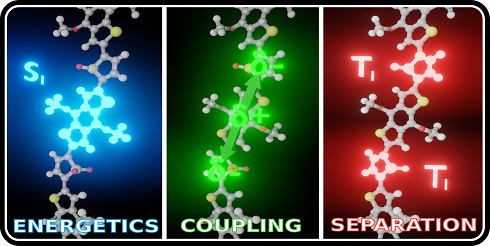Designing Singlet Fission Candidates from Donor-Acceptor Copolymers
Singlet fission (SF) has shown great potential to improve the power conversion efficiency in photovoltaic devices by means of promoting singlet-triplet exciton splitting upon the absorption of light.[1] Traditionally, SF is targeted as an intermolecular process, however its dependence on crystal packing makes molecular design difficult. In contrast, intramolecular SF (iSF) enables the exploration of tunable bi-chromophoric systems following well-defined structure-property relationships. However, the number of reported materials that undergo both inter- and intramolecular singlet fission remains remarkably narrow, and clear trends pointing towards new materials have not yet been established. In this context, the building-block approach to conjugated donor-acceptor polymer synthesis provides fertile ground to formulate simple and robust rules for the design of candidates which respond to SF requirements, namely appropriate energies and electronic coupling.[2,3] In this work, we focus our analysis on the E(S1)≥2E(T1) thermodynamic condition, the appropriate charge transfer (CT) character of the S1 state and the geometric separation of the local T1 states in the material.[4] These parameters, computed using time-dependent density functional theory, are initially applied to a small, chemically diverse, curated library of truncated dimers of synthetically feasible donor-acceptor copolymers. The efficiency of the protocol is validated by the correct identification of some of the few materials that have previously exhibited SF behaviour experimentally. Furthermore, we demonstrate that the CT character of the excited state can be mapped to the frontier molecular orbital energies of the constituent monomers, thus providing a cost-effective initial step for an accelerated screening of promising iSF donor-acceptor pairs. This computationally cheap and scalable framework has been applied to a database constructed of 5888 unexplored, though synthetically accessible, donor-acceptor compounds.[5] By means of high-throughput screening, our approach identifies novel copolymers potentially capable of iSF, thereby enriching the palette of singlet fission materials.

[1] Millicent B. Smith, Josef Michl, Chem. Rev., 2010, 110, 6891-6936.
[2] David Casanova, Chem. Rev., 2018, 118, 7164-7207.
[3] Eric Busby, Jianlong Xia, Qin Wu, Jonathan Z. Low, Rui Song, John R. Miller, Xiaoyang Zhu, Luis M. Campos, Matthew Y. Sfeir, Nat. Mater., 2015, 14, 426-433.
[4] J. Terence Blaskovits, Maria Fumanal, Sergi Vela, Clémence Corminboeuf, 2020, DOI: 10.26434/chemrxiv.11861817.v2
[5] J. Terence Blaskovits, Maria Fumanal, Sergi Vela, Clémence Corminboeuf, Manuscript in preparation.